One of the most intriguing structures humans ever created is located in Egypt.
It’s one of the most buildings in Egypt and one of the most fascinating sights you’ll ever see. It certainly deserves its place in the list of 7 wonders of the ancient world.
In fact, the Egyptian pyramids are still causing debates amongst scholars and archeologists all around the world, even though they were created over 4,000 years ago.
In this post, you’ll discover the ultimate list of facts about the Great Pyramid of Giza, the most intriguing of them all.
1. What is the Great Pyramid of Giza?
The Great Pyramid of Giza is both the largest and the oldest Pyramid built in the Giza Temple complex, also referred to as the “Giza Necropolis.”
There are several smaller pyramids on the site as well, including the Pyramid of Khafre and the Pyramid of Menkaure. There are also several cemeteries and the world-famous “Great Sphinx of Giza.”
The Great Pyramid of Giza is believed to have been built as a tomb for the pharaoh Khufu hence it’s also sometimes referred to as the “Pyramid of Khufu.”
The Great Pyramid of Giza stands 138.8 meters (455 ft) tall and the base has a length of 230.34 meters (756 ft).

2. When was the Great Pyramid of Giza built?
In one of the interior chambers there is a mention of the Fourth Dynasty, and a mention of Pharaoh Khufu as well.

The Fourth Dynasty, also often referred to as the “golden age” of the ancient Egyptian civilization lasted from about 2,613 until 2,494 B.C.
Pharaoh Khufu, who was known to the ancient Greeks as “Cheops” and who was the second pharaoh of the Fourth Dynasty, ruled Egypt between 2589 and 2566 B.C. according to modern historians.
This means that the Great Pyramid of Giza was built in between those years in the 26th century B.C.
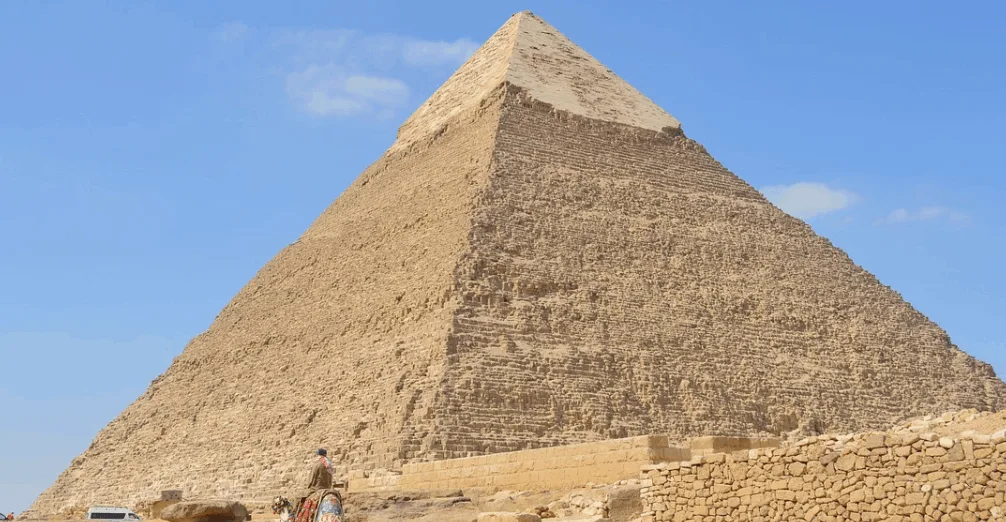
3. Why was the Great Pyramid of Giza built?
There are many theories about the exact reason as to why the Great Pyramid of Giza was built, but since there are inscriptions in one of the chambers, it’s widely accepted that it was a tomb for Pharaoh Khufu.
Pyramids were also built for religious purposes. Ancient Egyptians firmly believed in an afterlife and a second being that referred to as “ka” would enter it after the person died.
That’s also the exact reason the Pyramids were stuffed with treasure and other goodies inside the tomb’s chamber, so the “ka” could have an enjoyable time in the afterlife.
We are positive that Pharaoh Khufu has everything he needs.
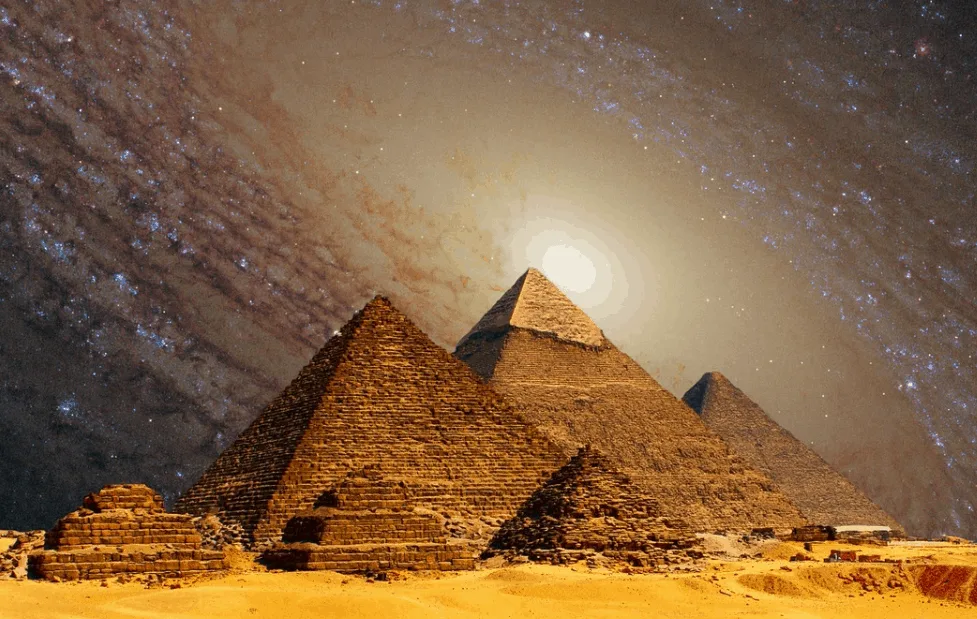
4. How was the Great Pyramid of Giza built?
How on earth was an ancient civilization, that didn’t have access to modern tools such as cranes and trucks, able to build an enormous structure like that Great Pyramid of Giza?
It is believed that the limestones that used to cover the surface of the pyramid were quarried from the area the pyramid was built. The big granite stones however that were used to build the “King’s Chamber” are believed to have been quarried near Aswan, hundreds of kilometers away.
Transportation of the stones quarried in Aswan was done using the Nile River, and somehow the huge stones were dragged and lifted into place.
It was a huge undertaking that made it necessary for an average workforce of about 14,500 skilled laborers to work on the project, with a peak workforce of up to 40,000 people.
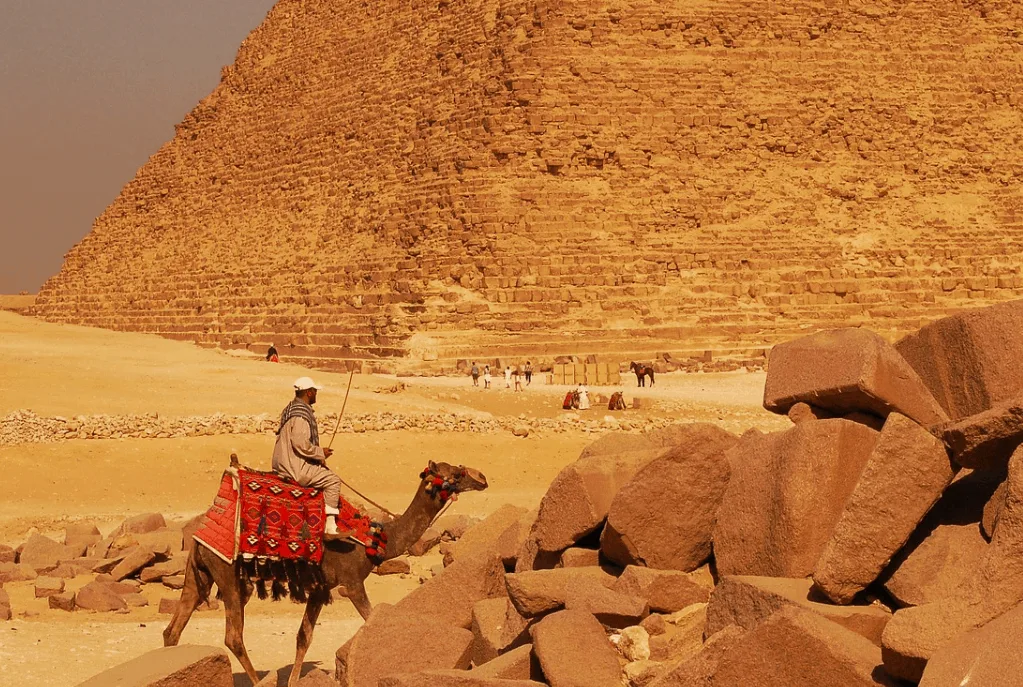
5. What’s included inside the Great Pyramid of Giza?
Remarkably, there isn’t a whole lot inside the Great Pyramid of Giza. Apart from a few passageways and two chambers, there’s nothing else, meaning it’s basically a huge grave and nothing else.
What can be found in the Great Pyramid of Giza is the following:
- Lower chamber – A subterranean chamber that is left unfinished.
- Queen’s chamber – Probably a storage room for Khufu’s things in the afterlife.
- The Grand Gallery – Passageway leading to the main chamber.
- The Big Void – A large cavity above the Big Void. Its purpose is still unknown.
- King’s Chamber – The room containing the pharaoh’s sarcophagus.
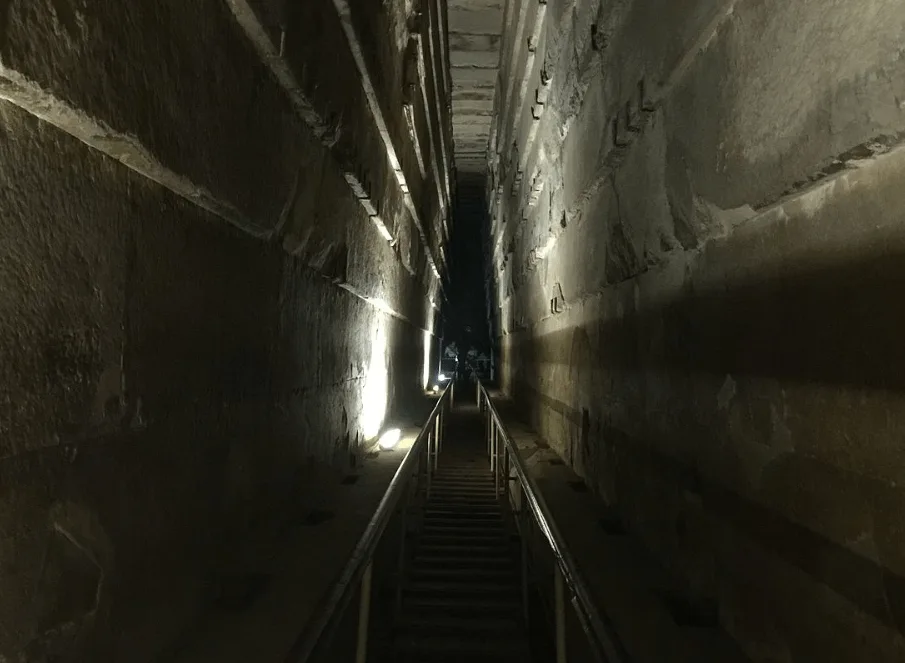
6. What happened to the Great Pyramid of Giza?
Just as many ancient monuments, the Great Pyramid of Giza has been looted by either graverobbers or to fund the construction of new buildings.
Some claim that all pyramids were robbed by the “New Kingdom,” commonly known as the “Egyptian Empire,” who subsequently built their tombs in the “Valley of the Kings.” The most famous tomb there is that of pharaoh Tutankhamun.
In 820 A.D. Caliph al-Mamun found the ultimate way to loot the Great Pyramid of Giza of its treasures. He had his men create a huge battering ram, the type used during sieges to penetrate a castle or city wall for instance.
This tunnel is referred to as the “Robber’s Tunnel” and is used by tourists as an entrance to get inside Khufu’s Great Pyramid.

More interesting facts about the Great Pyramid of Giza
Below you can find the remaining items in the ultimate list of facts about the Great Pyramid of Giza.
7. Khufu’s Pyramid is the only wonder still intact
Apart from being the largest and oldest monument on the list of 7 wonders of the ancient world, it’s also the only one that remained pretty much intact.
Monuments such as the Lighthouse of Alexandria, The Colossus of Rhodes, The Hanging Gardens of Babylon, the Statue of Zeus at Olympia, the Mausoleum at Halicarnassus, and the Temple of Artemis at Ephesus have all succumbed to history and been destroyed.
8. The Pyramid used to be a bit higher
The original height of the Pyramid was actually 7.9 meters (26 ft) higher than it is today. It used to be covered with shiny limestones but this has all been removed.
The main reason it has shrunk almost 8 meters is because of the absence of its pyramidion, its uppermost piece, allowing erosion to take bites from the pyramid for over 4,000 years.
9. The capstone of the pyramid has been replaced
At the moment, an iron triangle sits atop of the pyramid, which marks what once was the pyramidion or capstone of the Great Pyramid of Giza.
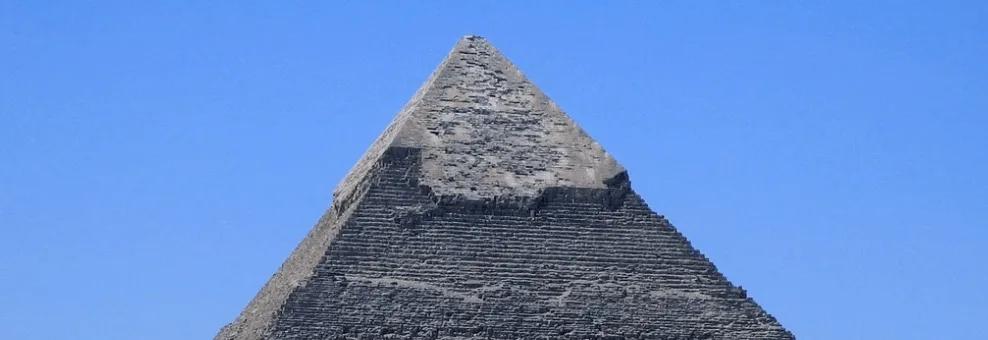
10. The pyramid used to be shiny white
The building we see today when we look at the Great Pyramid of Giza is actually the core structure.
The outer layer used to be decorated with white and shiny limestone, which gave the pyramid a completely different appearance than the grim, brownish, rocky pyramid we see today.

11. It was the tallest man-made structure for very long
The Great Pyramid wasn’t just the tallest man-made structure in the ancient world. it has been the tallest man-made structure for over 3,800 years.
It was finally surpassed by the Lincoln Cathedral which was completed in the year 1311 A.D. and had a spire that was 160 meters tall (520 ft).

12. The Great Pyramid is part of a greater complex
The Great Pyramid of Giza is part of a greater complex called the “Giza pyramid complex,” also known as the “Giza Necropolis,” and is located in Giza, just outside of the modern-day city of Caïro in Egypt.
13. What was the second-largest pyramid ever built?
The second-largest pyramid that was ever built in Ancient Egypt is the Pyramid of Khafre, which is also part of the Giza Pyramid complex.
Khafre is actually the son of Khufu, so he must have had both inspirations from his father because he built pretty much the same pyramid as Khufu, but also respect because he didn’t try to outdo him and made his own pyramid just a bit smaller with a total height of 143.5 meters (471 ft) and a length of the base of 215.25 meters (706 ft).
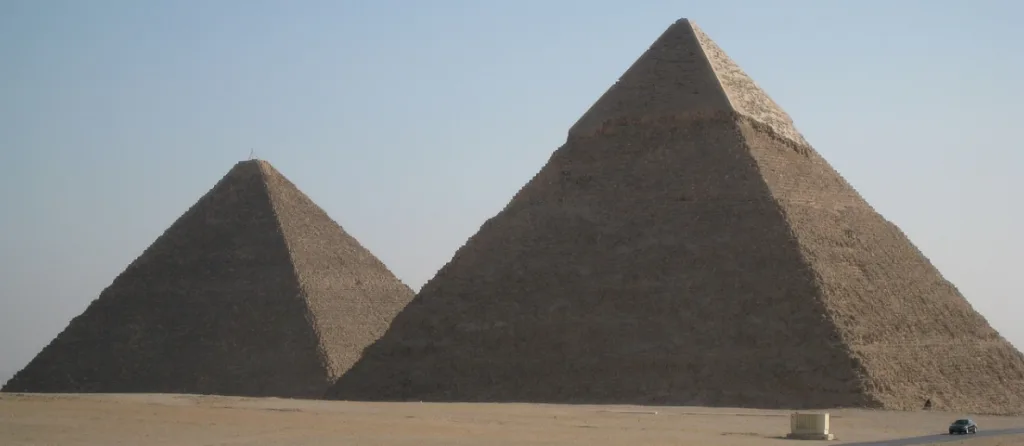
14. What was the oldest pyramid ever built?
The Great Pyramid of Giza is actually not the oldest pyramid that was ever completed.
About a century earlier, somewhere between 2613 and 2589 B.C., pharaoh Snefuru built the “Red Pyramid,” which is believed to be the oldest true pyramid that was fully finished.
15. What was the oldest non-true pyramid ever built?
When we refer to the oldest true Pyramid, we actually mean the oldest pyramid that has the same style as the Great Pyramid of Giza.
One pharaoh named Djoser beat them all and was the first pharaoh that moved tombs from below the ground to the above-ground in what is referred to as his “Step Pyramid” which was completed around 2,630 B.C. in a place called Saqqara.
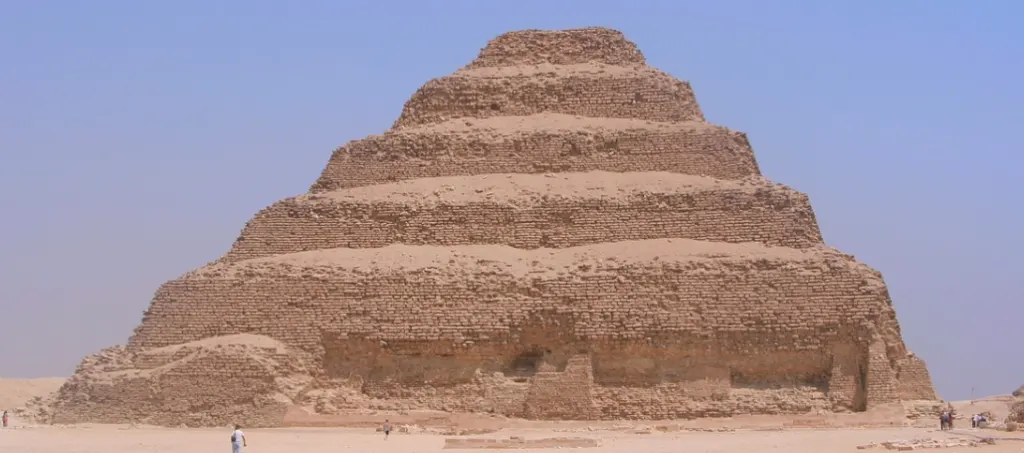
16. The technical ability of the Ancient Egyptians was amazing
The Ancient Egyptians were technically well ahead of their time. It’s actually one of the most accurately aligned buildings in history, aligning perfectly to the north.
Considering the sheer size of the structure, the margin of error of 3/60th of a degree is pretty much negligible.
17. What was the margin of error in the length of the 4 bases?
There’s more proof of the high level of craftsmanship by the Ancient Egyptians. According to measurements from the Cole Survey done in 1925, the lengths of the base on each side are 230.252 meters, 230.454 meters, 230.391 meters, 230.357 meters.
This means the average margin of error on all sides is just 58 millimeters. We’re talking about twice the length of a football field here so this is pretty amazing!
18. How long did it take to complete the pyramid?
While this remains open for debate, it’s estimated that the time it took to complete the pyramid was in between 10 and 20 years.
19. The Giza Necropolis consists of many structures, including the pyramids of Khufu’s son and grandson, the pyramids for his wives, mortuary temples, a causeway, boat pits, cemeteries, multiple separate tombs, and last but not least, the famous “Great Sphinx of Giza.”
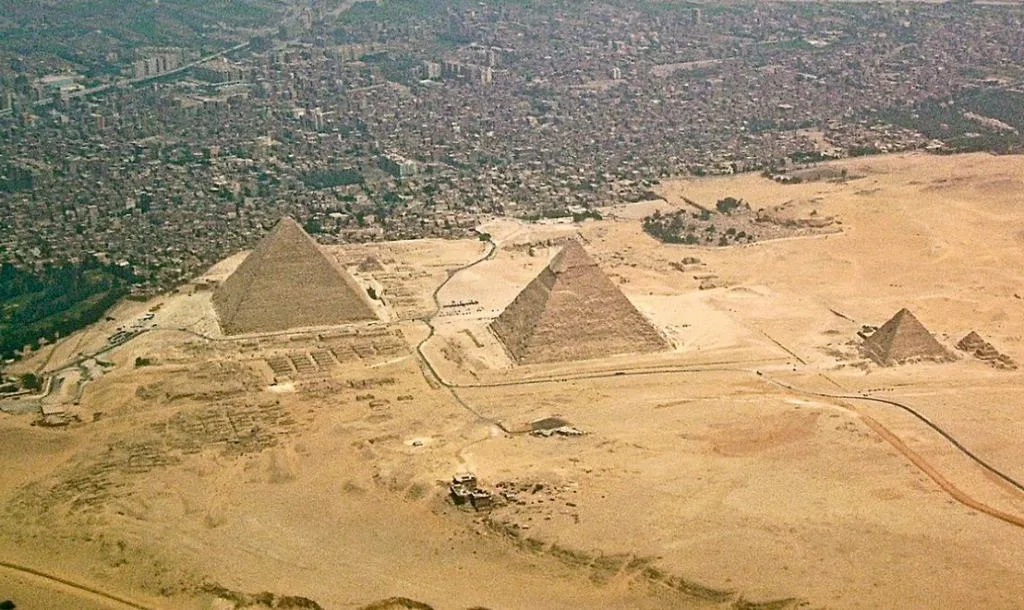
20. How many stone blocks were used to build the Great Pyramid of Giza?
If we look at the numbers, we can only conclude that the construction of the Great Pyramid of Giza is a true miracle.
It’s estimated that over 2.3 million blocks of stone, all weighing thousands of kilos, have been quarried and transported to be used for its construction.
21. What stones were used to build the Great Pyramid?
Most of the Great Pyramid of Giza consists of limestone. Estimates put the total amount of limestone used in the pyramid at 5.5 billion kilos.
The huge granite stones were quarried in and transported from Aswan. The estimate is that 8 million kilos of granite stones were used to build the inner chambers.
Finally, to make things stick together, about 5 million kilos of mortar was used as well.
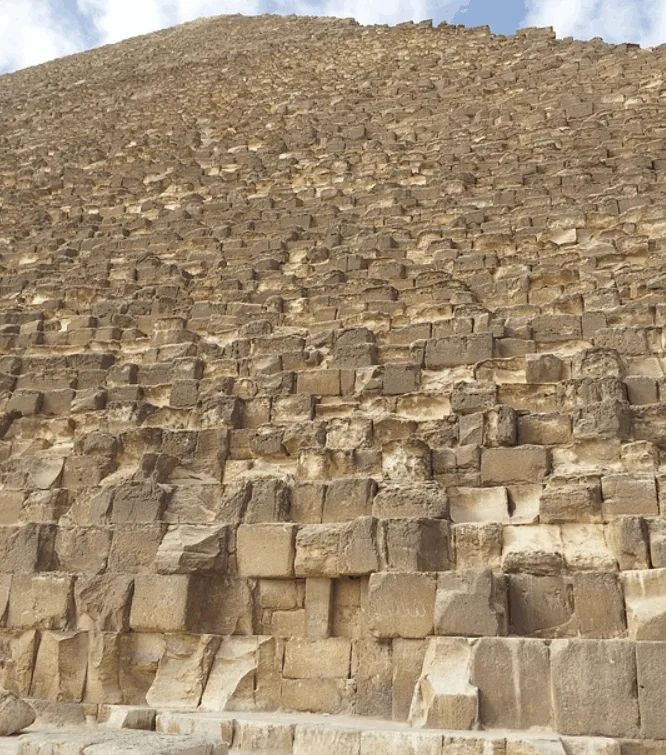
22. How did the Ancient Egyptians work the stones?
Ancient Egyptians didn’t have the tools we know today. They didn’t’ even had iron tools such as hammers and definitely no drills, which would have been pretty handy to cut the huge stones.
Instead, they used ancient techniques. They first made carvings into the stones and filled these carvings with sticks that they soaked in water. When the wood expanded, it created cracks in the stones that they could then work with to make the stones the right size.
23. How was the Great Pyramid of Giza built?
Many historians believe, even though there is no hard evidence, that ramps were used to drag the stones up the higher levels.
Since there were no cranes, this seems to be pretty logical.
24. The Great Pyramid had a very smooth surface
The outer layer of the Pyramid was made with very smooth white casing stones, consisting of polished limestones. So the surface of the pyramid would have been pretty smooth in ancient times.
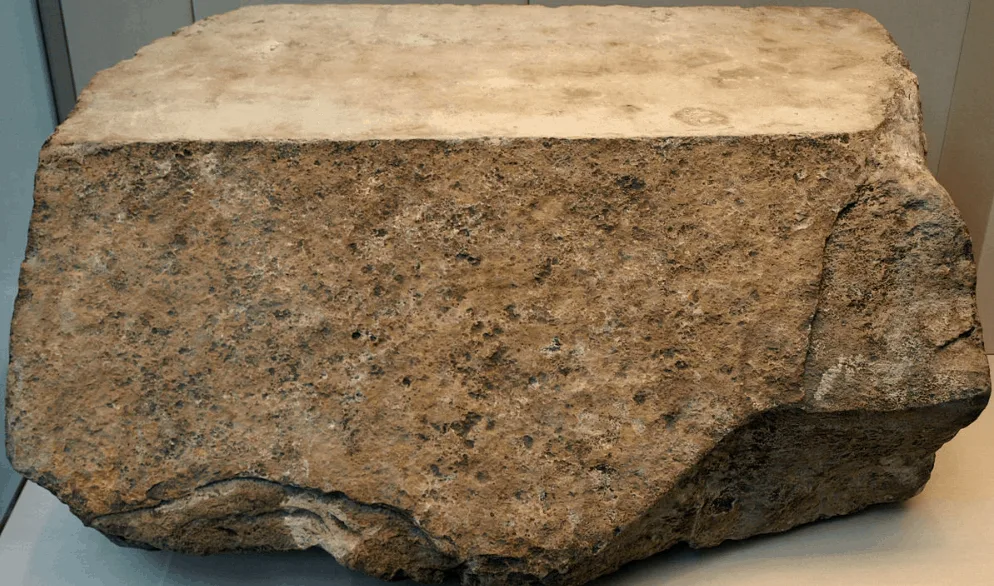
25. The casing stones were perfectly cut
There were a total of 144,000 of these casing stones, each about 2 and a half meters thick (over 100 inches), weighing about 15,000 kilos each.
They were also cut to perfection, only having a margin of error of about 1/4 of a millimeter each (1/100 of an inch).
26. Were the pyramids aligned with the stars?
Apart from being very meticulous planners to ensure the margin of error during construction was extremely limited, Ancient Egyptians were also great astronomers.
Better yet, the 3 main pyramids in the Giza Necropolis, the Great Pyramid of Khufu, the Pyramid of Menkaure, and the Pyramid of Khafre are perfectly aligned with the constellation of Orion.
27. Did slaves build the pyramids?
For a long time, it was believed that slaves were used to build the Great Pyramid of Giza. Recent discoveries lean more to the fact that it was actually skilled laborers who helped with construction for a salary.
This would mean that Pharaoh Khufu had deep pockets as it must have cost a fortune to pay all those workers for over a decade.

28. Herodotus’ story about the workforce
The Greek historian Herodotus visited Egypt, and more particularly the Giza Necropolis, in 450 B.C.
He was told there by Egyptian priests that “the Great Pyramid had taken 400,000 men 20 years to build, working in three-month shifts 100,000 men at a time.”
29. There was a full-time workforce at the site
Excavations have uncovered an artisans’ village which could house about 5,000 people. This, along with the words written by Herodotus, leads to the conclusion that there were about 5,000 people who worked on the project full-time and stayed at the site.
Then there were seasonal workers, for example, farmers who couldn’t work their fields when the Nile flooded them, who worked on the project on and off.
30. How much did the stones to build the pyramid weigh?
The stones that were used to build Khufu’s pyramid weighed about 5 to 10,000 kilos. That’s about the same weight as a heavy African bush elephant. Makes it all the more impressive that they were able to move around over 2.3 million of these right?

31. How big is the size that the Great Pyramid covers?
If we look at the base of the Great Pyramid of Giza, we can see that it covers almost 53,000 square meters (570,000 square feet). This makes the base the equivalent size of over 10 football/soccer fields!
32. Where did the casing stones that covered the pyramid go?
Many of the casing stones that made the pyramid shine in the sun have been loosened from the major earthquake in 1303 A.D. (the earthquake which destroyed a few of the other ancient wonders as well).
Arabic Sultans have stolen these stones and used them to build various mosques in the region.
33. How did Khufu call his pyramid?
Khufu gave his construction the name “Akhet Khufu.” This literally translates to “Khufu’s Horizon.” What a humble man Khufu must have been…
34. How did the Ancient Egyptians call the Great Pyramid of Giza?
But Akhet Khufu isn’t the only “nickname” the Great Pyramid got. The Ancient Egyptians used to call it “Ikhet,” which literally translates to “glorious light.”
Because of the brightly polished limestones that covered the Great Pyramid, it is believed that it shone from miles away, and it would have been possible to see it from the moon, shining like a star on earth!
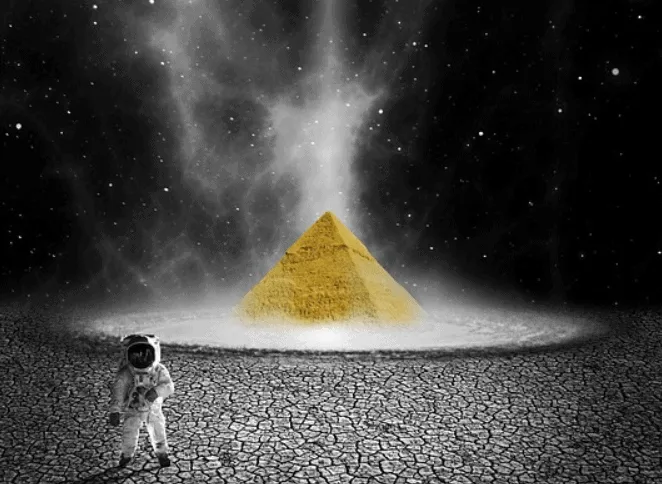
35. Dragging big stones is easier as it seems according to a study
So transporting massive stone blocks that weigh thousands of kilos was an enormous task. But was it really?
According to a study, when blocks are put on a slick surface, perfectly positioned to leverage the weight, it is fairly easy to pull a stone weighing over 1,500 kilos over a long distance with just 12 people. Obviously, it still required a lot of manpower to do this and that’s just one stone.
36. The Great Pyramid is an ancient cooler
The temperature inside the Great Pyramid of Giza, regardless of the blistering sun of the desert it’s located in, remains 20 degrees Celcius (68 Degrees Fahrenheit) at all times. Remarkably, that’s the exact average temperature of the earth.
37. The Great Pyramid of Giza is located in the center of the earth
Were the Ancient Egyptians so far ahead of their time that they could predict that Giza is located at the geographical center of the earth?
This is known to be the geometric center of all land surfaces on earth and would most probably be the last piece of land to survive a cataclysmic event.
38. The granite sarcophagus wasn’t brought into the pyramid
The granite sarcophagus that is found in the King’s chamber looks pretty ordinary, doesn’t it?
Until you start to realize that there is no way they could have brought the huge granite stone it is made of through the narrow passages to reach the King’s Chamber.
This most probably means they actually put the sarcophagus in position and built the pyramid around it.
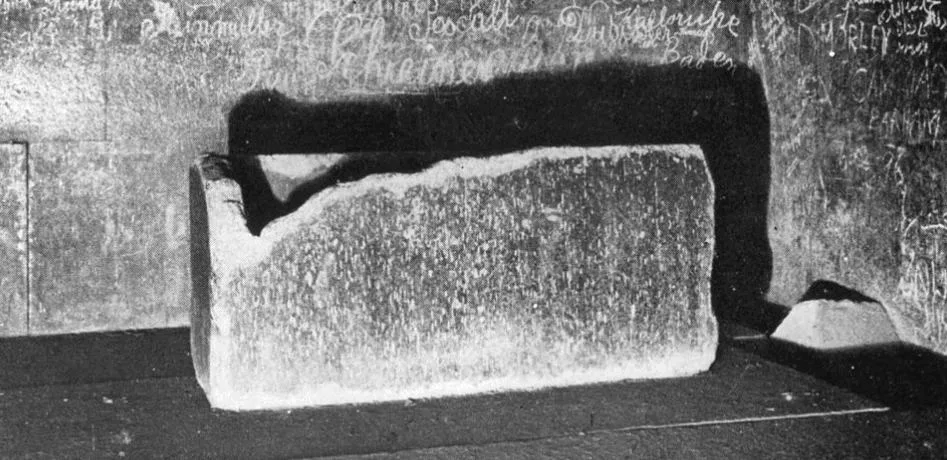
39. How did the Ancient Egyptians carve out the sarcophagus?
Another interesting fact about the Great Pyramid of Giza is that this granite coffer had to be carved out by an enormously powerful drill that had teeth made out of sapphire.
Research has shown that “it was made with a fixed point drill that used hard jewel bits and a drilling force of 2 tons.” was that even possible in those days?
40. Does the Great Pyramid of Giza have 4 sides?
When you take a good look at the Great Pyramid of Giza, you will most definitely conclude that it has 4 sides, right?
Well, your conclusion would be wrong. The Great Pyramid’s four sides are actually slightly concave and are indented the same with amazing precision. This simply means that the Great Pyramid of Giza actually has 8 sides instead of the 4 you see at first glance.
41. How were the Pyramid’s 4 extra sides discovered?
It’s impossible to spot the 8 sides of the Pyramid from the ground, it can only be seen from the air. Better yet, it can only be seen at specific times, such as the dawn and dusk of the spring and autumn equinoxes.
This was discovered by a British pilot named P. Groves as he was flying right above the pyramids. he was so fascinated by what he saw that he took a picture of this curiosity nobody else was aware of until then.
One of the most interesting facts about the pyramid of Giza and its 8 faces is that it’s the only pyramid that was made this way. Nobody knows why.
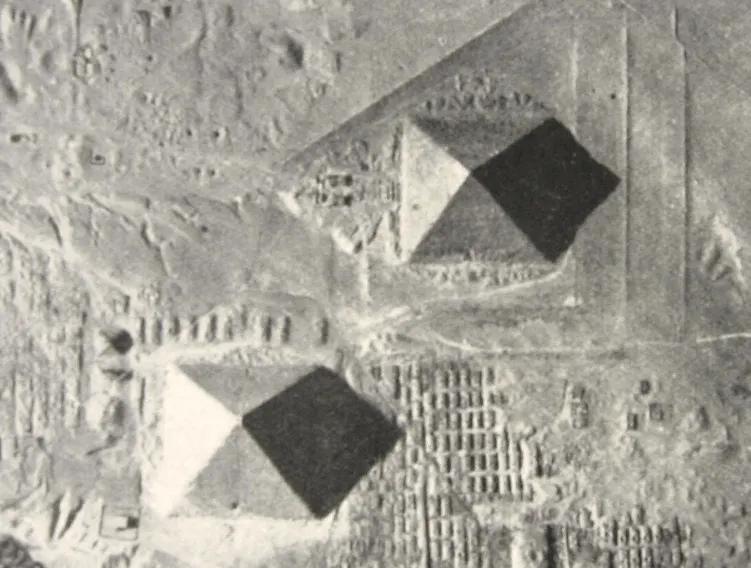
42. The Great Pyramid and the radius of the earth
Amazingly, the curvature of these 8 faces of the Great Pyramid of Giza exactly matches the radius of the earth.
43. What’s the secret of the Pyramid’s durability?
Ever heard the Arab proverb “Man fears time, but time fears the pyramids?” Well, there is certainly some truth in it.
The secret reason the pyramids are still standing so strong while all other ancient monuments are crumbling away is the mortar used to glue the stones together. It contains a secret sauce that scientists can’t wrap their heads around. In other words, they are clueless about what it’s made of!
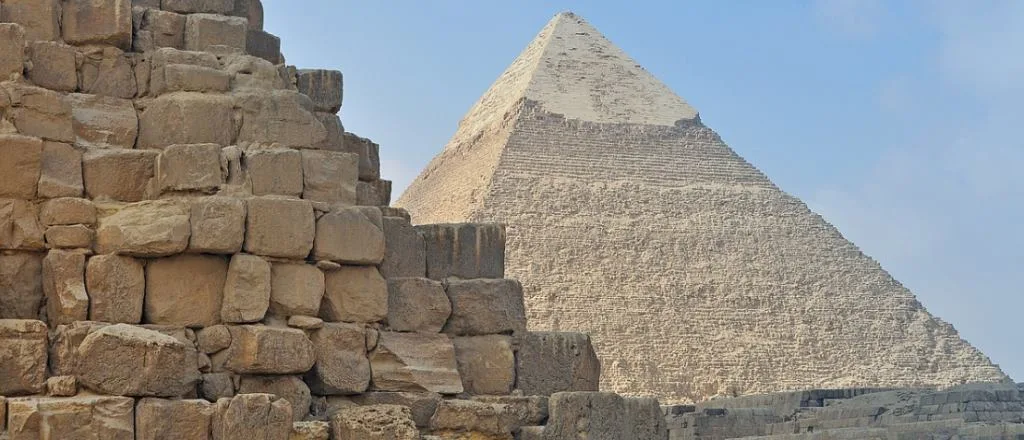
44. Could we recreate the Great Pyramid of Giza?
Apart from the mortar, the exact technology that the Ancient Egyptians used to construct such a massive building is still unknown. What does this mean?
It means that if we would try to replicate what they did to build a new great Pyramid of Giza, we simply wouldn’t be able to!
45. Did the Great Pyramid of Giza have a swivel door?
Opening a 20-ton swivel door was easy, finding it? Not so much… The Great Pyramid of Giza is one of three pyramids that used to have a swivel door.
it was easy to operate from the inside and only required a little nudge to open it. If you were on the outside, it was virtually impossible to find, even if you know where it was approximately located. It’s said that it was so well balanced that you couldn’t even put a needle in between the openings.
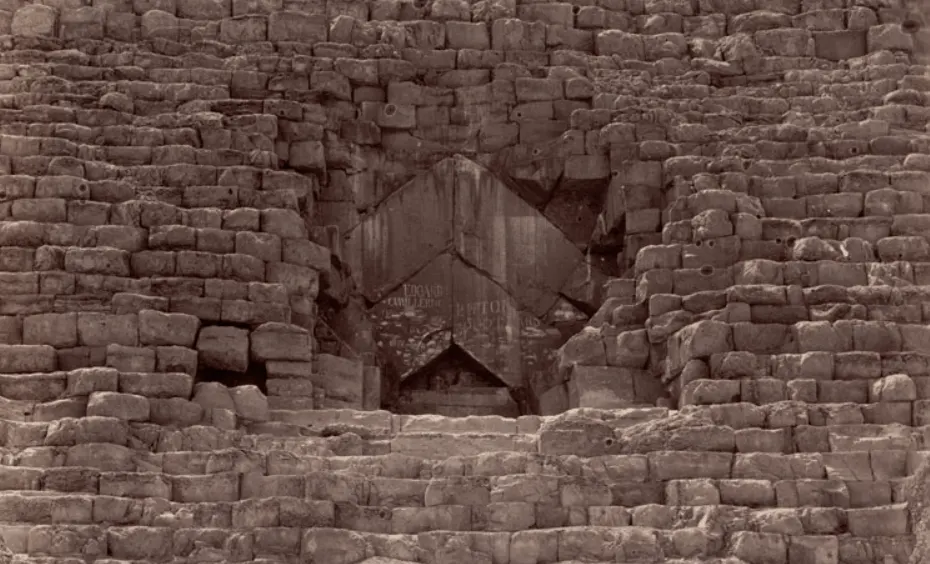
46. How much does the Great Pyramid of Giza weigh?
The tallest structure of the ancient world weighs a stunning 5.75 million tonnes. If we compare that with the weight of the tallest structure on earth today (at least in 2020) the Burj Khalifa, this one only weighs half a million tonnes.
47. Are there hieroglyphics on the Great Pyramid’s walls?
One of the most interesting facts about the Great Pyramid of Giza is that it doesn’t contain any of the hieroglyphics you can find in Ancient Egyptian temples all around the ancient empire. This is until a robot found ancient “graffiti” in a secret room of the Great Pyramid back in 2011.
48. Can you climb the Great Pyramid of Giza?
Ok, surely some of you adventurers see this amazing structure and have just one thing in mind: “I want to get on top of that!” Well, there might be unpleasant consequences if you try to do that.
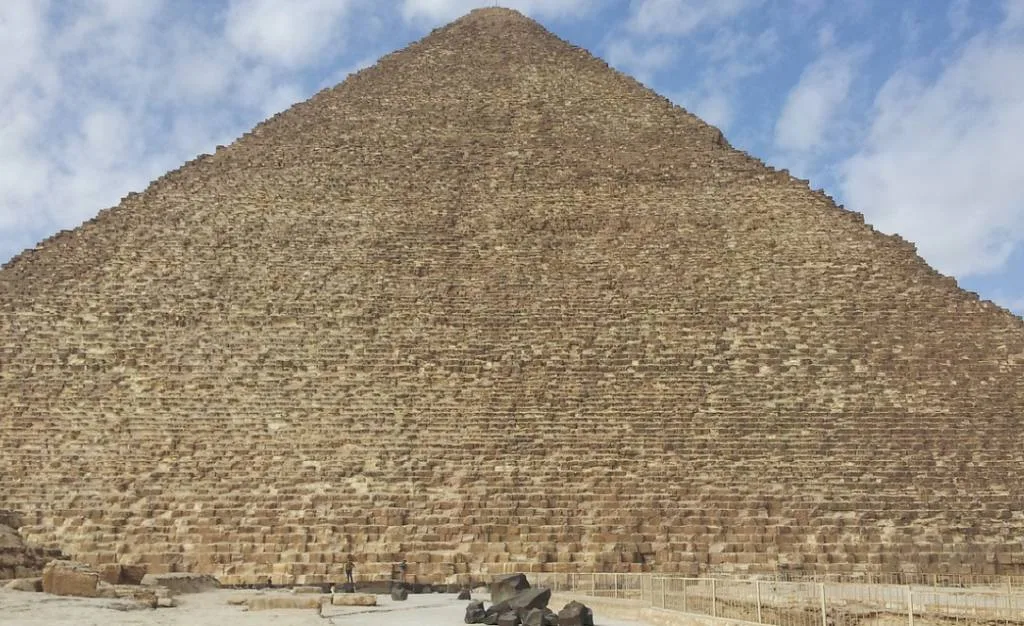
49. Does the Great Pyramid of Giza hold more secrets?
We are 100% sure that the Great Pyramid of Giza hasn’t given up all its secrets. A Japanese team is currently working on examining the Great Pyramid of Giza with advanced robot technology, and it’s bound to reveal some interesting stuff. I think we need to stay tuned for this one!

Leave a comment
You must be logged in to post a comment.